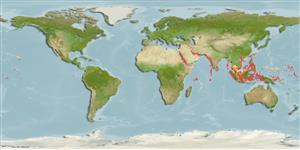Common names from other countries
>
Eupercaria/misc (Various families in series Eupercaria) >
Haemulidae (Grunts) > Plectorhinchinae
Etymology: Plectorhinchus: Greek, plektos = plaited + Greek, rhyngchos = snout (Ref. 45335).
More on author: Rüppell.
Environment: milieu / climate zone / depth range / distribution range
Ecología
marino; salobre asociado a arrecife; rango de profundidad 2 - 50 m (Ref. 9710). Tropical; 30°N - 7°S
Indo-West Pacific: Red Sea and Madagascar to Fiji and Micronesia; north to Ryukyu andn south to the Great Barrier Reef and New Caledonia.
Tamaño / Peso / Age
Maturity: Lm ? range ? - ? cm
Max length : 100.0 cm SL macho / no sexado; (Ref. 48635)
Espinas dorsales (total) : 13; Radios blandos dorsales (total) : 17 - 18; Espinas anales: 3; Radios blandos anales: 7.
Found in clear lagoon and seaward reefs. Juveniles in brackish habitats or shallow turbid coastal areas (Ref. 9710). Adults usually solitary, occasionally in pairs; on deep reefs or with sea mounts (Ref. 48635). At Palau, aggregates to spawn about once a year around new moon of April or May (Ref. 37816).
Life cycle and mating behavior
Maturities | Reproducción | Spawnings | Egg(s) | Fecundities | Larva
Oviparous, distinct pairing during breeding (Ref. 205).
Myers, R.F., 1991. Micronesian reef fishes. Second Ed. Coral Graphics, Barrigada, Guam. 298 p. (Ref. 1602)
IUCN Red List Status (Ref. 130435)
CITES (Ref. 128078)
Not Evaluated
Threat to humans
Harmless
Human uses
Warning: mysqli::__construct(): (HY000/1040): Too many connections in /var/www/html/includes/func_getlabel.php on line 46
Can't connect to MySQL database (fbapp). Errorcode: Too many connections
